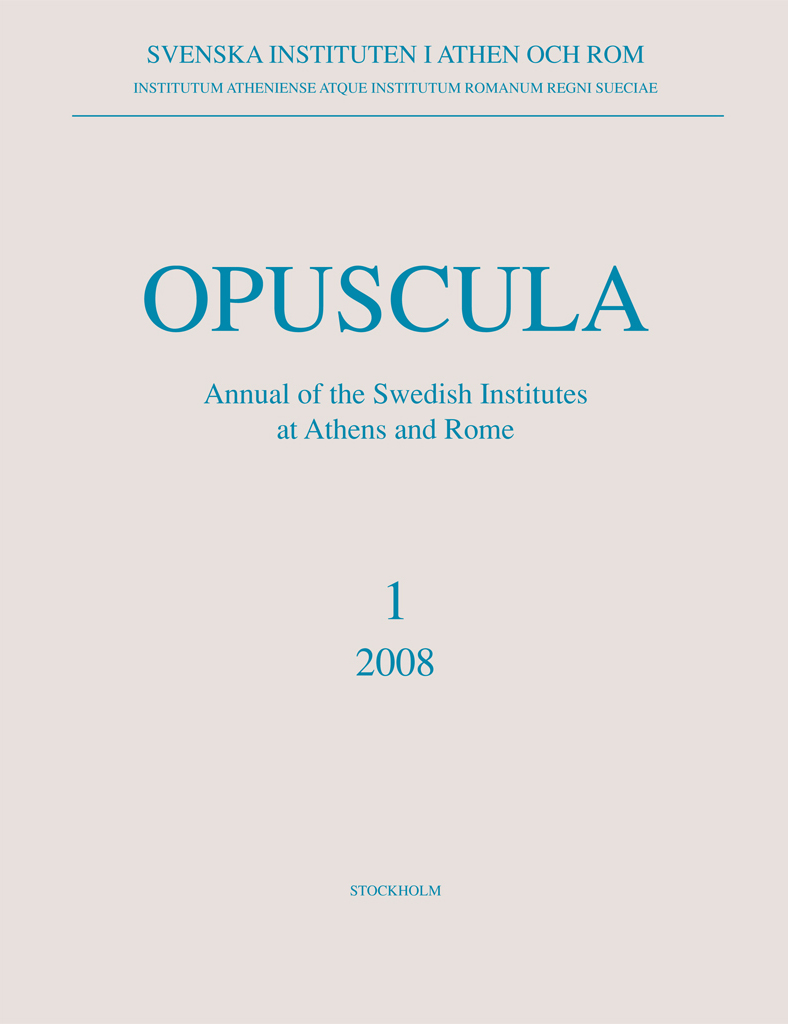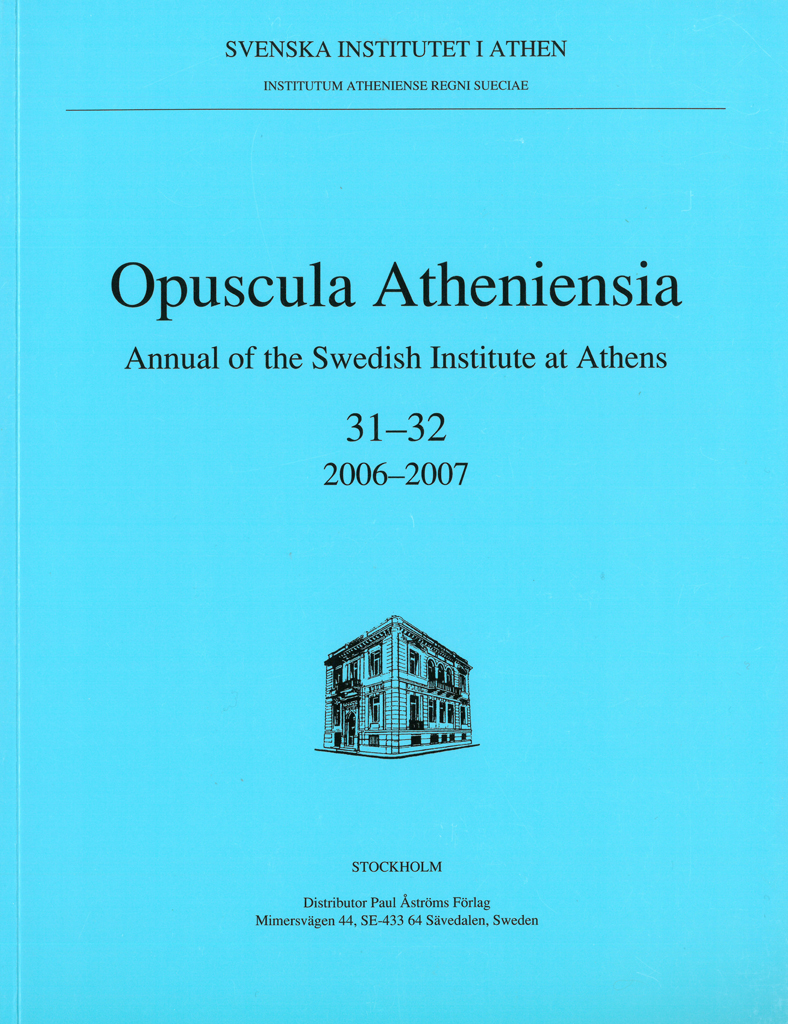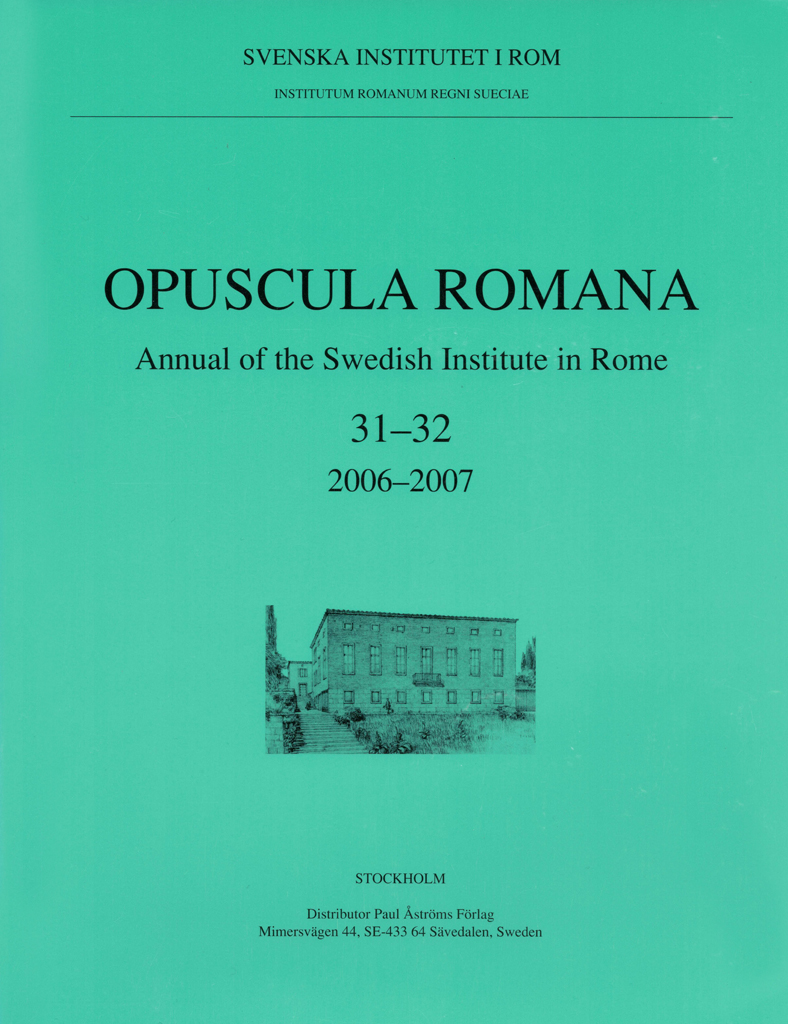Opuscula 1 (2008) is out of print. Available for free download at Bokorder.se. Used copies might be available at Amazon.com and Amazon.de. The religio-social message of the gold tablets from Pyrgi By Ola Wikander Abstract The gold tablets from Pyrgi, studied many times for linguistic and philological reasons, constitute a clear example of religio-social ideology at work. They deploy their themes (the goddess, the ruler, the sanctuary) in a way that helps create the symbolical universe of the readers, in whose world it is inscribed that these things are part of a greater, orderly whole. The texts are here analysed from the points of view of ideology, power and religious tendency, as parts of the system of religious symbolism that they seek to legitimize. Rhetorical points are also touched upon, as well as the fundamental question of the implied readership of the texts. This contribution is only available in print. Bibliographical information Ola Wikander, ‘The religio-social message of the gold tablets from Pyrgi’, Opuscula. Annual of the Swedish Institutes at Athens and Rome (OpAthRom) 1, 79–84. Stockholm 2008. ISSN: 2000-0898. ISBN: 978-91-977798-0-7. Softcover, 198 pages. https://doi.org/10.30549/opathrom-01-06
Opuscula 1 (2008) is out of print. Available for free download at Bokorder.se. Used copies might be available at Amazon.com and Amazon.de. Una nuova acquisizione di ceramica “white-on-red” dall’ager Veientanus By Fabrizio Vistoli Abstract This paper presents an unpublished clay plate with painted decoration found during field surveys conducted in 1994 inside the area of a new Etruscan settlement discovered in the district of “Acquatraversa”, nearby the ancient route of via Veientana (Rome). The analytical study of this important and typical object, besides comparison with related pottery, makes it possible to assign its date exactly to the beginning of the last quarter of seventh century BC, as well as to suggest that it was manufactured in the territory of ancient Capena. Bibliographical information Fabrizio Vistoli, ‘Una nuova acquisizione di ceramica “white-on-red” dall’ager Veientanus’, Opuscula. Annual of the Swedish Institutes at Athens and Rome (OpAthRom) 1, 63–77. Stockholm 2008. ISSN: 2000-0898. ISBN: 978-91-977798-0-7. Softcover, 198 pages. https://doi.org/10.30549/opathrom-01-05
Opuscula 1 (2008) is out of print. Available for free download at Bokorder.se. Used copies might be available at Amazon.com and Amazon.de. Epineia kai limenes: the relationship between harbours and cities in ancient Greek texts By Anton Bonnier Abstract The aim of this article is to explore the relationship between harbours and cities as presented in literary sources dating primarily to the Archaic and Classical periods. Although it has been recognized that access to the sea and sailing routes was of great importance for the economic and political life of ancient Greek city-states, there have been few studies of the relationship between cities and harbours, and in particular of the emblematic role played by harbours within literary sources. Harbours are often presented as extramural entities in relation to cities and although urban centres would depend on harbours for the import and export of goods, and for maintaining navies, the relationship between harbours and cities is not unproblematic if we look at what harbours signify within these texts. Bibliographical information Anton Bonnier, ‘Epineia kai limenes: the relationship between harbours and cities in ancient Greek texts’, Opuscula. Annual of the Swedish Institutes at Athens and Rome (OpAthRom) 1, 47–61. Stockholm 2008….
Opuscula 1 (2008) is out of print. Available for free download at Bokorder.se. Used copies might be available at Amazon.com and Amazon.de. The Archaic wall of Athens: reality or myth? By John K. Papadopoulos Abstract This paper reviews the philological and archaeological evidence for an Archaic, pre-Persian, city wall of Athens, and concludes that there was no Archaic enceinte separate from the fortifications of the Acropolis and Pelargikon. The extant testimonia, primarily Thucydides and Herodotos, can be interpreted in different ways, but there is nothing in these sources to suggest categorically fortifications other than those of the Acropolis/Pelargikon. Previous arguments put forward for the existence of such a putative wall do not stand up to closer scrutiny and, despite extensive excavations in those areas where the wall has been claimed, there is to date no archaeological evidence for an Archaic wall. The wall that the Persians breached in their sack of Athens in 480/79 B.C. was the Mycenaean circuit wall surrounding the Acropolis and Pelargikon; together these walls, built in the Mycenaean period, continued to serve through the Archaic period until 479 B.C. when work was begun on the Themistoklean Wall. Bibliographical information John K. Papadopoulos, ‘The Archaic wall of…
Opuscula 1 (2008) is out of print. Available for free download at Bokorder.se. Used copies might be available at Amazon.com and Amazon.de. Excavations in Midea 2006 By Katie Demakopoulou, Nicoletta Divari-Valakou, Monica Nilsson, Ann-Louise Schallin & Kalliopi Nikita Abstract Excavations in Midea continued in 2006 as a Greek-Swedish programme under the direction of Dr. Katie Demakopoulou in collaboration with Dr. Ann-Louise Schallin. In the Upper Acropolis remains of an Early Helladic II defensive system were uncovered. East of this and at a lower level, a floor deposit was excavated with abundant pottery of Early Helladic I date including typical examples of the Talioti Ware. In the West Gate area excavation continued in the west part of the building complex adjacent to the fortification wall. Abundant Late helladic IIIB2 pottery was recovered from the exploration of two more rooms of the complex. A new trench was opened on the lower west terrace of the Acropolis in order to expose the line and the entire width of the fortification wall, which is almost completely covered by accumulated deposits in this area. Excavation was resumed in the East Gate area with the removal of a wide baulk and the investigation of the space…
Out of print. Available for free download, use links below. Used copies might be available at Amazon.com and Amazon.de. View this volume at ERIH PLUS. Contents Katie Demakopoulou, Nicoletta Divari-Valakou, Monica Nilsson, Ann-Louise Schallin, with an appendix by Kalliopi Nikita | Excavations in Midea 2006 John K. Papadopoulos | The Archaic wall of Athens. Reality or myth? Anton Bonnier | Epineia kai limenes. The relationship between harbours and cities in ancient Greek texts Fabrizio Vistoli | Una nuova acquisizione di ceramica “white-on red” dall’ager Veientanus Ola Wikander | The religio-social message of the gold tablets of Pyrgi Milette Gaifmann | Visualized rituals and dedicatory inscriptions on votive offerings to the Nymphs Gabriella Barbieri | Materiali inediti da Sovana. Alcuni corredi funerari dalla necropoli di San Sebastiano Maria Gabriella Scapaticci | Nuovi dati sul popolamento nella pianura di Tarquinia durante la romanizzazione. Il caso della località “Il Giglio” Paavo Roos | A forgotten tomb at Hippokome and its neighbours Henrik Gerding | Reconsidering the tomb of Aulus Hirtius Olof Brandt | I muri traversali di Santa Croce in Gerusalemme e la sinagoga di Ostia Carmen Marcks | Die Büste eines Afrikaners aus der Sammlung Piranesi in Stockholm In memoriam Paul Åström…
Now available for purchase at Amazon.com, Amazon.de, Bokus.com, Adlibris.com, and Bokorder.se Contents Katie Demakopoulou, Nicoletta Divari-Valakou, Monica Nilsson & Ann-Louise Schallin | Excavations in Midea 2005 Berit Wells, Arto Penttinen & Jenni Hjohlman, with contributions by Kristian Göransson, Arja Karivieri & Maria Daniela Trifirò | The Kalaureia Excavation Project. The 2004 and 2005 seasons Mats Johnson | Early farming in the land of springs. Settlement patterns and agriculture in Neolithic Greece Mercourios Georgiadis & Chrysanthi Gallou | The cemeteries of the Argolid and the south-eastern Aegean during the Mycenaean period. A landscape and waterscape assessment Helène Whittaker | Burnt animal sacrifice in Mycenaean cult. A review of the evidence David S. Reese | Organic imports from Late Bronze Age Cyprus (with special reference to Hala Sultan Tekke) Helen Mangou, Michalis Petropoulos, Alexander Gasparatos, Elias Tsakmakis & Panayiotis V. Ioannou | The temple of Artemis (F)aontia, at Rakita, Achaia, Greece. Chemical compositions of metal and glass votives Lena Sjögren | The Eteocretans. Ancient traditions and modern constructions of ethnic identity Jesper Blid | New research on Carian Labraunda in Late Antiquity Book reviews Bibliographical information Opuscula Atheniensia. Annual of the Swedish Institute at Athens (OpAth) 31–32, Stockholm 2007. ISSN: 0078-5520. ISBN:…
Now available for purchase at Amazon.com, Amazon.de, Bokus.com, Adlibris.com, and Bokorder.se. Contents Johnny R. Bengtsson | Late Bronze Age handles from the Apennine settlement at Luni sul Mignone: Some chronological observations Ingela M.B. Wiman & Yvonne Backe-Forsberg | Surfacing deities in later Etruscan art and the sacellum at San Giovenale Allan Klynne | The Villa Selvasecca revisited John W. Hayes | Villa Selvasecca: the pottery finds Ebba Engström & Ragnar Hedlund | Villa Selvasecca: the coins Dominic Ingemark | Villa Selvasecca: the glass Anne-Marie Leander Touati | Interim report of the Swedish Pompeii Project: Work 2000–2004/5 in Insula V 1. Introduction Margareta Staub Gierow | The House of the Greek Epigrams V 1,18.11–12: preliminary report 2000–2004 Arja Karivieri & Renée Forsell | The House of Caecilius Iucundus, V 1,22–27: a preliminary report Henrik Boman & Monica Nilsson | The commercial establishments V 1,13; V 1, 14–16; V 1,20–21: preliminary report 2001–2004 Mark Robinson | Evidence for garden cultivation and the use of bedding-out plants in the peristyle garden of the House of the Greek Epigrams (V 1, 18i) at Pompeii Henrik Boman & Monica Nilsson | The early street and the prehistoric finds in Vicolo delle Nozze d’Argento, Pompeii Jörg…




